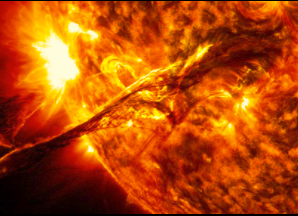space planet
There are many different planets in the universe. Let's take a look at the gas planets among the planets we know well. The gas planets are Jupiter, Saturn, Uranus, and Neptune. Jupiter: The largest planet in the solar system. It is the fifth closest planet from the Sun. Represents a Jupiter (or gaseous) planet. Jupiter was discovered by Galileo Galileo. Jupiter is a gaseous planet. About 89% of its composition is hydrogen, and about 10% is helium. Others include methane (about 0.3%), ammonia (about 0.026%), deuterium (HD; about 0.0028%) ), ethane (about 0.0006), and water (0.0004%) in small amounts. Among them, ammonia, water, and ammonium hydrogen sulfide (NH4) are also present in the form of particles (aerosol). Light streaks, dark streaks, and small and large spots are observed on the surface as shown in Figure 1. The light stripes are called Zones and the dark stripes are called Belts. Belts and belts exhibit different wind speeds, and recent exploration of Juno has shown that these streaks extend to depths of 3,000 km and vary in depth due to the inhomogeneity of Jupiter's gravitational field. These patterns are also used in Jupiter's atmosphere studies to identify regions on Jupiter's surface. Saturn (soil texture): As we all know, Saturn is a beautiful planet with rings. Saturn was first observed by Galileo Galileo, but it is Huygens Huygens that the planet is Saturn. Like Jupiter, Saturn's atmosphere has bands, which are fainter than Jupiter's and relatively thicker at the equator. However, the number of vortices is relatively small compared to Jupiter, and although large vortices sometimes appear, they are very small compared to Jupiter's Great Red Spot. The composition of Saturn's atmosphere is also similar to that of Jupiter. So far, methane, ammonia, ethane, helium, and hydrogen molecules have been detected, and hydrogen molecules are said to be the most abundant. The temperature on Saturn's surface (the top of the clouds) is very low, around -176°C. Due to the low temperature, the clouds are located at a low altitude, so the color is less distinct than that of Jupiter. Saturn, like Jupiter, also radiates more energy than it receives from the sun. However, energy due to gravitational contraction like Jupiter is insufficient to explain. Astronomers place the source of that energy in Helium rain. In other words, it explains that there is less helium in the upper atmosphere compared to other Jupiter planets. In Saturn, where the temperature is low, helium descends downward and energy is generated by friction when passing through liquid hydrogen. Uranus: Beyond Saturn's orbit is the turquoise planet Uranus. Uranus was first observed and discovered by William Herschel. The rings look very fine. Uranus's atmosphere contains about 83% hydrogen, 15% helium, 2% methane, etc., with highly reflective ammonia and sulfur deep in the atmosphere. Uranus's atmosphere is turquoise overall because it absorbs the red wavelengths of sunlight and reflects much of the blue and green wavelengths. According to infrared observations, the temperature of Uranus is approximately -215°C. This is higher than the energy received from the sun, and it is estimated that there is a heat source inside Uranus like Jupiter or Saturn. The energy emitted is very small compared to Jupiter, Saturn, and Neptune, and the internal energy of Uranus is also formed by planets. The source would be the gravitational energy caused by the gases collapsing when they are formed. The interior of Uranus is slightly different from that of Jupiter and Saturn. Although hydrogen in liquid metal exists due to high pressure inside Jupiter and Saturn, it is assumed that the internal pressure of Uranus is insufficient to convert hydrogen into liquid metal. Therefore, it is assumed that the ice of methane and ammonia in the atmosphere is ionized by pressure. Judging from its low pressure and similar density (about 1,271 kg/m³) and low temperature compared to Jupiter, it is believed that Uranus has a small content of hydrogen and helium, and that rocks and ice exist. Uranus rotates with its axis lying on the plane of the ecliptic. The rotation of Uranus is very peculiar. Unlike other planets, it rotates with its axis lying on the plane of the ecliptic. In other words, the equatorial plane of Uranus rotates in a reverse direction tilted by about 98° to its orbital plane, and the period is about -17 hours (‘-’ means reverse rotation). There were many difficulties in how to obtain this rotation period. There was a limit to applying the Doppler effect because the axis of rotation was too tilted, and there was an error in the rotation period calculated through ground observation. Infrared observation obtained a value close to the actual rotation period, but in the end, it was possible to determine the rotation period of Uranus by measuring the magnetic field of Voyager. Due to the tilt of the axis of rotation, the poles receive more solar heat than those around the equator, but strangely, the overall temperature is uniform. Uranus orbits at a distance of 2.88 billion km from the Sun, and its orbital period is approximately 84 years. Uranus also orbits the sun in the form of an ellipse like other planets, and when it is close to the sun, it is about 2.74 billion km, and when it is far away, it falls to about 3 billion km. And it orbits at about 6.8 km/s, which is slower than other planets. Uranus has a relatively strong magnetic field. The axis of the magnetic field (the imaginary axis connecting the south and north of the magnetic field) is tilted about 59° relative to Uranus's axis of rotation. High-energy particles are trapped in Uranus' magnetic radiation band, but not strong enough to be found on Earth. The particles were discovered by Voyager 2. A photograph of Uranus' rings. Uranus' rings were discovered by accident. It was discovered while observing an eclipse (a phenomenon in which Uranus blocks the stars in the background) to find out the physical properties of Uranus. The starlight changed its brightness several times before it was obscured by Uranus, and the same phenomenon was observed when it reappeared. From this observation, astronomers found that it was the rings of Uranus that blocked the star's light. In this way, nine rings were discovered by observations from Earth. The remaining rings were identified only by Voyager 2 and Hubble as the environment. The reason why Uranus' rings are not easily found on Earth is that they are very dark, about 1/3 million the brightness of Saturn's rings. Whereas Saturn's rings reflect most of the light, Uranus's rings are made up of dust and small grains of black ice that reflect only about 1% of the light (I wrote that it was too long). Neptune: Neptune is the most distant planet in the solar system. Neptune, like other Jupiter planets, is a gaseous planet made of gas and does not have a solid surface, so an area with a pressure of 1 atmosphere is used as the standard for measuring its size. When this criterion is applied, Neptune's size is 24,764 km, which is 3.883 times the equatorial radius of the Earth, and the pole radius is 24,341 km, which is 3.829 times the Earth's, which is slightly smaller than Uranus. Table 1. Main physical quantities of Neptune Physical Quantity Classification Neptune's Physical Quantity Compared to Earth (Earth Physical Quantity = 1) Mass 102.413x1024 kg 17.15 times Volume 6,253x1010 km3 57.74 times Equatorial radius (based on 1 atm) 24,764 km 3.883 times Polar radius (based on 1 atm) 24,341 km 3.829 times Escape speed 23.5 kms-1 2.10 times Orbit major radius 4,495.06x106 km 30.047 times Orbital inclination angle (based on Earth's orbit) 1.769 degrees - orbital period (sidereal days) 60,189 days 164.79 times Rotational period (by sidereal time, based on magnetic field coordinates) 16.11 hours 0.673 times Air temperature 72K (1 atm), 55K (0.1 atm) - Wind speed 0~580ms-1 - Neptune is the only planet (as of March 2019) that cannot be seen without the aid of a telescope. Its location was mathematically predicted before it was discovered. The first observations of Neptune were recorded by the Italian astronomer Galileo Galilei (February 15, 1564 – January 8, 1642) using his telescope from December 28, 1612 to January 27, 1613. There are records of Neptune's movements up to this day. However, Galileo at the time mistakenly thought of Neptune as a star, so he did not think of it as another planet. French astronomer Alexis Boubard (June 27, 1767 - June 7, 1848) observed an unexpected change in the orbit of Uranus and inferred that it was being perturbed by the gravity of an undiscovered planet. also did Later, French mathematician Urbain Jean Joseph Le Verrier (March 11, 1811 – September 23, 1877) first predicted the orbit of Neptune by calculation, and in 1846, Johann Gottfried Galle , June 9, 1812 - July 10, 1910) was the first to observe Neptune within that range using the position of Neptune predicted by Leberier's calculations. Neptune's atmosphere is composed of components similar to those of Uranus, and because it is a gas, 1 atmosphere (1 bar) is considered as the surface and the atmosphere above it. Neptune's surface looks similar to Uranus, but in reality, unlike Uranus, meteorological phenomena occur actively. Rapid wind movements are observed in Neptune's atmosphere, with wind speeds reaching 600 ms-1 in strong storms. Clouds appear in the atmosphere, and the moving speed of the atmosphere, measured based on the motion of the clouds, ranges from -20ms-1 to 400ms-1 (the sign indicates the direction). In particular, large-scale storm areas called 'Great Dark Spots' and smaller 'sunspots' are often found on the surface of Neptune. Meteorological events are relatively less active on the surface of Uranus, but more active on Neptune. Scientists believe that one of the reasons is that the thermal energy is much greater than the gravitational energy generated inside Neptune. i.e. the sea king







